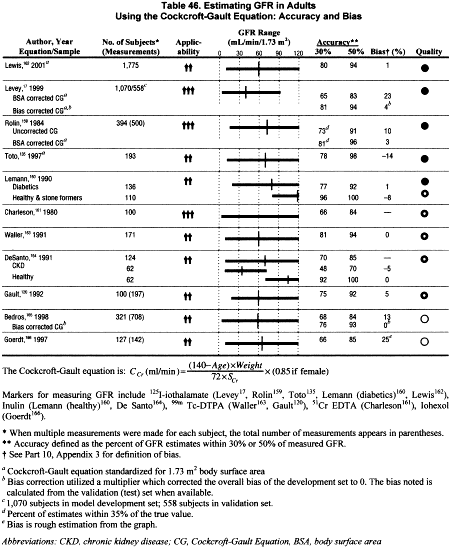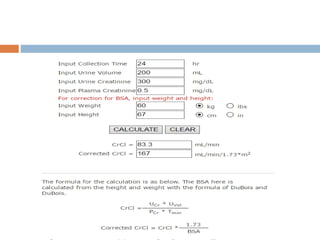

Many equations have an adjustment factor to account for the fact that female patients have less muscle mass, and therefore produce less creatinine.

The study used actual body weight, but mentioned that a correction factor of some kind should be used in patients with marked obesity or ascites. The original study was based on data from 249 male patients with stable renal function. Particularly for renally dosing medications, the Cockcroft-Gault equation has been the long-standing gold standard for the estimation of creatinine clearance for decades.

The typical range for serum creatinine is: Serum creatinine is reported as milligrams of creatinine to a deciliter of blood (mg/dL) or micromoles of creatinine to a liter of blood (micromoles/L). The measure of serum creatinine may also be used to estimate how quickly the kidneys filter blood (glomerular filtration rate). The formula for calculating GFR takes into account the serum creatinine count and other factors, such as age and sex.īecause of variability in serum creatinine from one person to another, the GFR may provide a more accurate reading on kidney function. A GFR score below 60 suggests kidney disease. The range of scores below 60 may be used to monitor treatment and disease progression. Creatinine clearanceĬreatinine clearance is a measure of how well the kidneys filter creatinine out of the bloodstream for excretion in urine.Ĭreatinine clearance is usually determined from a measurement of creatinine in a 24-hour urine sample and from a serum sample taken during the same time period. However, shorter time periods for urine samples may be used. Accurate timing and collection of the urine sample is important.Ĭreatinine clearance is reported as milliliters of creatinine per minute per body surface area (mL/min/BSA). The typical range, by age, for creatinine clearance in women is as follows: The typical range for men, 19 to 75 years old, is 77 to 160 mL/min/BSA. Standard measures have not been determined for older adults. Results lower than the typical range for your age group may be a sign of poor kidney function or conditions that affect blood flow to your kidneys. Albumin/creatinine ratioĪnother interpretation of urine creatinine count is called the albumin/creatinine ratio. Healthy kidneys generally don't filter it out of the blood, so there should be little to no albumin found in the urine.Īlbumin/creatinine ratio describes how much albumin is in a urine sample relative to how much creatinine there is. The results are reported as the number of milligrams (mg) of albumin for every gram (g) of creatinine. Results indicating a healthy kidney are:Ī higher than typical result may be a sign of kidney disease. In particular, the result may indicate a complication of diabetes called diabetic nephropathy, or diabetic kidney disease.


 0 kommentar(er)
0 kommentar(er)
